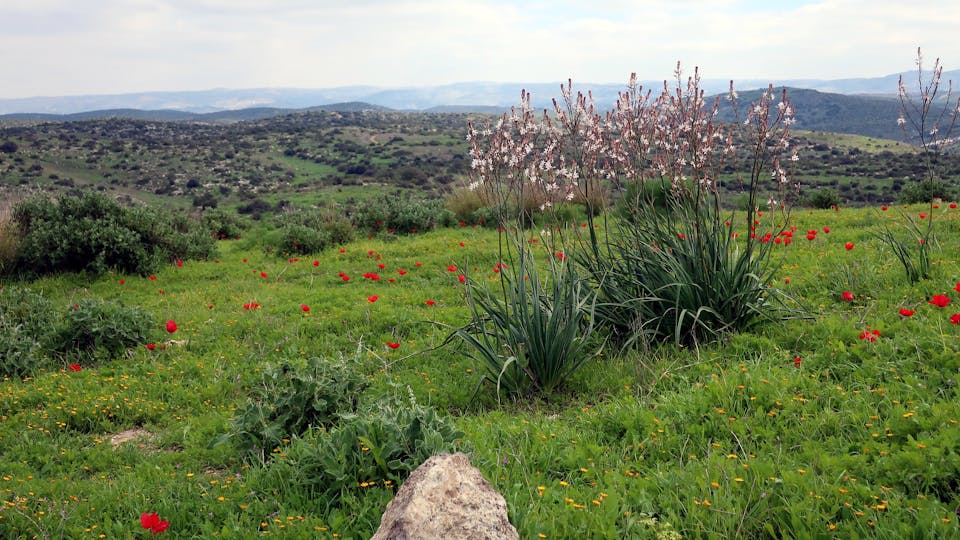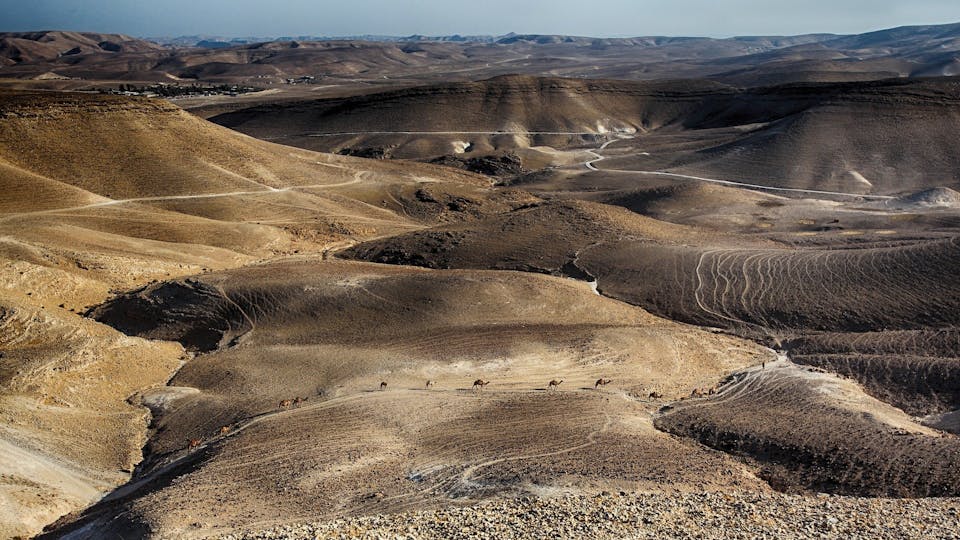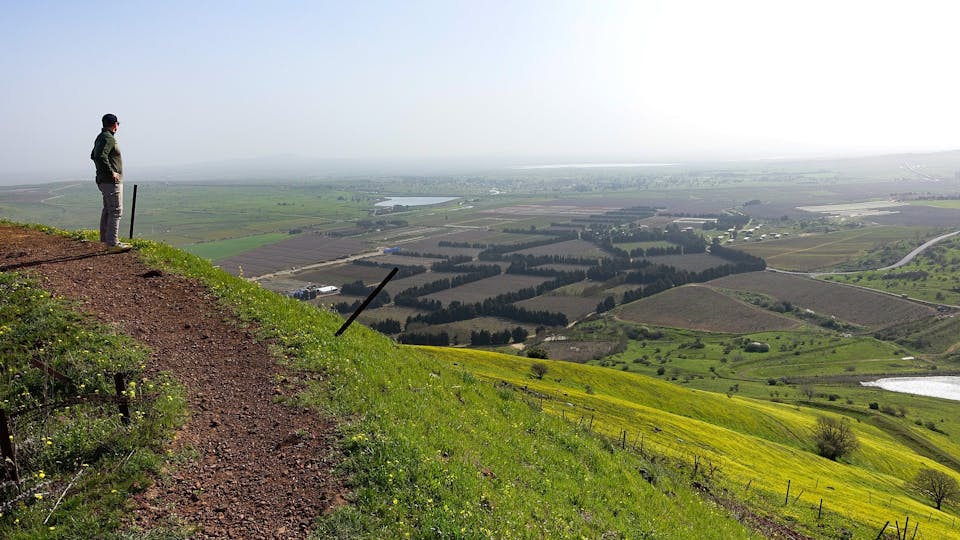11 Best Hikes In Israel

Israel is a haven for hikers, a trekking paradise full of cragged mountains, verdant forests, and sparse deserts. And the entire country is crisscrossed with spectacular trails to explore, from quick half-day jaunts to epic multi-month excursions.
Although many of the nation’s top trails are dangerous to tackle alone (we recommend using a guide), the hardest part about hiking in Israel is deciding where to go.
We’ve compiled a list of its top 11 trails to unravel the enigma and add adventure to your trip. So strap on your hiking boots and make haste to these amazing trails—Israel’s immense natural beauty awaits.
1. The Israel Trail
The Israel Trail is the mother of all Israeli hikes, a heroic cross-country saga stretching over a thousand kilometers from the Lebanese border to the Red Sea. National Geographic recognized it as one of the top 20 Epic Hiking Trails of the world, and the route has achieved legendary status ever since.
Also known as the Israel National Trail, the hike came about when Israeli journalist Avraham Tamir finished the Appalachian Trail and lobbied the government to create something similar at home. The Israeli President inaugurated the trail in 1994, allowing his people to experience the full breadth of their homeland in one epic saga.
Of course, the 45 to 60-day trek is no easy feat, so only the hardiest of hikers should consider taking it on. Four out of ten people who attempt the route never see the finish line—the Israel Trails Committee later subdivided it into smaller, more manageable chunks.
If you’re tempted to give the whole trail a shot, aim to start and finish within the temperate months of February to May. Large swathes of the route traverse through isolated areas, so you’ll need to organize food supplies in advance (Sar-El Tours can help you there).
Not feeling enthused by a thousand-kilometer walk? Then you can explore the entire route from your living room on Google Street View instead.

2. The Gospel Trail
Combine your love of the great outdoors with your passion for Christ by trekking along the sacred Gospel Trail. Also known as the Jesus Trail, the historic route follows the path Jesus is thought to have taken when he departed his childhood home of Nazareth and ventured towards Capernaum on the shores of the Sea of Galilee.
The 63 km trail has been a hit with Christian pilgrims since the Israel Ministry of Tourism opened it in 2011. If you don’t want—or aren’t physically fit enough—to take on the entire route, the Ministry has separated the trail into smaller sections that are easy to manage for casual trekkers.
Alternatively, if you don’t fancy hiking at all, there’s the option to follow the trail by bike, car, or even a sailboat as you straddle the coastline of the Sea of Galilee. It’s possible to mix and match on the sacred pilgrimage as well, switching from one form of transport to another. Sar-El Tours organizes bespoke trips along the Gospel Trail, and can even include a traditional horse-drawn carriage so visitors can feel a closer connection with the era.
Pilgrims get to choose from one of two variations (Nazareth to Capernaum or a coastal route down the Sea of Galilee), each with an array of intriguing holy sites to visit along the way. Some of the highlights include Mount Tabor and the Church of the Transfiguration, Mary Magdalene’s home in ancient Magdala, and the Horns of Hittin where the crusaders battled against the Muslim armies of Saladin.
3. Ein Gedi Reserve
Situated on the shores of the Dead Sea, the Ein Gedi Reserve is among the most popular spots for outdoor recreation in all of Israel. The spectacular nature reserve is home to countless crystal clear cascades, many with thick throngs of ivy clinging to the cliff to create a ‘Garden of Eden’ like effect. The Bible tells how this was the place where King David hid from Saul, making it of great religious importance as well.
There are several hikes to choose from in the vicinity, the Nahal David trail being the best. This easily accessible hike takes only an hour or so, making it a popular trip for people of all ages and abilities. En route, you’ll pass a series of bubbling streams and tranquil ponds before reaching the jaw-dropping Wadi David Waterfall, widely considered the finest in Israel.
If you’re after more adventure, try starting the trail at the nearby Ein Gedi Field School. From here, a rugged mountain path winds steadily upwards—at times, you’ll have to hang onto steel rungs dug into the cliff. At the end of the trail, you’ll encounter a scenic natural rock window that’s a brilliant place to pause and admire the view. On the way home, stop off at the Ein Gedi spring for a swim and venture into the ancient Chalcolithic-era temple. There’s also an ancient Jewish synagogue in the vicinity that’s well worth the detour.
4. Mount Sodom
The Bible tells how the wrath of God obliterated Sodom; it should come as no surprise to hear it’s a starkly inhospitable place.
Summertime temperatures top 50 degrees celsius despite the Dead Sea breeze, and there’s no shade in sight. The winter rains bring treacherous mudslides, so it’s best to attempt this one in spring or fall. What’s more, the arid landscape makes navigating a challenge, and you’ll need to keep a lookout for open shafts that fall into a maze of perilous caves—we highly recommend a guide.
Nonetheless, it’s a spectacular trip for those daring enough to brave the rugged landscape. The formidable mountain consists of 80% rock salt, a delicate and soluble material that melts in more humid climates. Varying sediment layers create a kaleidoscopic effect, with unusual rock formations scattered throughout the route.
Hikers have a choice of two trails to reach the top, both of which take about 90 minutes return. Ma’aleh HaSulamot, or the “Ladders Ascent,” is named for its steep staircases, while Shvil HaDagim, or the “Fish Trail,” is marked by fossilized fish embedded into the rock.
Upon reaching the top, hikers enjoy breathtaking views of the Moav Mountains across the border in Jordan and the Dead Sea.
5. Wadi Kelt
Wadi Kelt is one of Israel’s most heavily traversed trails; an estimated 60,000 hikers trample through it each year. The hike passes through two gorgeous national parks, Ein Prat and Ein Maboa, both of which have their own mini trails.
As the route receives so many visitors, you won’t find an available spot in the small onsite car park, so it’s best to use a prearranged travel service to take you there and back. Weekends are crowded but boast a festive atmosphere as outdoor enthusiasts from all walks of life make the most of the spectacular surroundings.
The popular spot has two routes to choose from: west towards Pisgat Ze’ev or east towards Jericho. Most hikers agree the eastern side has the best scenery for its craggy desert ravines and cool, refreshing swimming holes. Whichever direction you take, you’ll get to see the ancient Greek Orthodox Monastery of St. George, which dates back to 420 BC.
Allow at least five hours if you hope to make it to the monastery and back and contract the services of a local guide to ensure your safety on the trail.
6. Nahal Og
Nahal Og is unlike other hikes in Israel as it snakes its way through a series of sugary white chalk canyons.
For the most part, it’s a gentle trail that doesn’t present too much difficulty. But that all changes once you reach a steep precipice, where you have to carefully climb backwards down a rung ladder into the rock. The tricky part is you can’t see where you’re putting your feet, so it’s wise to enlist a guide to show you how it’s done.
If that sounds a little too terrifying, you can do the hike uphill by starting at the foot of Nahal Og and working your way upwards. It’s more of an effort and the views aren’t quite as superb, but you won’t have to stress about making a misstep on the ladder and falling into the abyss.
Energetic hikers can extend their journey towards the Jewish West Bank Village of Kfar Adumim, which takes around seven hours in total.

7. Nahal Yehudiah
Hiking in Israel’s intense summer heat generally isn’t recommended—unless, of course, you’re tackling the trails of Nahal Yehudiah. The scenic Yehudia Forest Reserve lies northeast of the Sea of Galilee and has a dozen or so hikes to choose from, but the coolest (speaking both figuratively and literally) is the Upper Nahal Yehudiah Trail.
Once you’ve wandered past the abandoned Syrian village, you’ll venture through lush pastures before arriving at the gushing Yehudiah Falls. From here, you climb down a cragged cliff using ladders drilled into the rock before reaching a refreshing pool.
The trail continues through other pristine pools, giving you ample opportunity to cool off from the heat. Some are deep enough for diving, so expect to see thrill-seekers launching themselves off the cliffs (always check the water level first).
Allow about five hours to return to the trailhead and pack a reliable waterproof bag to keep your cellphone safe.
8. Nahal Amud
Nahal Amud is said to be the most attractive stream in Israel, trickling all the way from Mount Meron to the Sea of Galilee. You can tackle the three-mile hike from either direction, although most trekkers prefer to start on Mount Meron and head east for an easy descent. Taxis are available at the bottom to whisk you back to the start, and there’s a tasty kebab shop to quell your hunger.
The trail straddles the scenic Amud stream, with inviting swimming holes, colorful wildflowers, and ancient watermills lining the route. Although you can expect to see flowing water the whole year round, there’s much more movement in the wetter months of winter and spring.
Nahal Amud means “Pillar Canyon,” which refers to the giant rocky column that pierces the sky at the end of the trail.
If you’re still feeling energetic, head back via Mizpe Hayamim to enjoy views of both the Mediterranean and the Sea of Galilee.
9. Mount Zefachot
Although the trail itself is arduous and not especially scenic, the views from the top of Mount Zefachot are to die for.
Situated near Eilat at the southern tip of the country, the summit of Zefachot (A.K.A Har Zefahot) affords sweeping vistas of four separate sovereign states: Israel, Jordan, Egypt, and Saudi Arabia. The sparkling blue waters of the Red Sea slice through the center to complete the jaw-dropping scene.
The mountain resides at the southernmost section of the Israel National Trail and serves as a euphoric finale to the exhausting 1,000 km hike. As the climate in southern Israel entails milder winters, it’s a popular route when the temperature plummets up north.
To return via a different route, take the trail towards Taba and then look for a public bus or taxi to bring you to your car. Expect to spend about four hours in total on the hike.

10. Amram’s Pillars + Black Canyon
About 15 minutes north of Eilat lies Amram’s Pillars, a series of impressive red sandstone columns that protrude into the sky. The unusual rock formation reminds many visitors of the nearby Timna Park and is one of the most photographed desert landscapes in all of Israel.
Getting there from the car park requires a 1.3 km hike that’s accessible to all ages and ventures through a rocky canyon. Avid hikers can continue their journey by ascending Mount Amir for a breathtaking overview of the area.
If you’re still keen for more, follow the Israel Trail towards Black Canyon, where giant grey granite rocks sit alongside huge swathes of white limestone chalk. The area has a labyrinth of narrow natural passageways, making it a fun spot to wander through.
Allow at least 5 hours if you plan to hike the whole thing.
11. Nahal Dragot
For the gung-ho hiker, few trails in Israel are as intense—or perilous—as Nahal Dragot, which winds from the Cliffs of the Judean Desert to the Dead Sea.. The excruciating circular hike is something of a rite of passage for young Israelis, and you won’t want to go it alone because there’s plenty of scope for misadventure.
You need a thick hiking rope and the know-how to use it if you want to navigate the tough terrain—think scaling sheer rock walls and wading through crater pools, among other things. Although a few good Samaritans have hammered stakes into the most challenging sections, this hike is still no easy feat—you’ll be pleased to make it to the end of the death-defying trail.
In case it wasn't obvious enough already, we highly recommend tackling Nahal Dragot with an experienced tour guide (preferably one with good knowledge of first aid!).
Sound a little too extreme for your liking? There are a number of less treacherous routes in the upper areas of the region that afford equally spectacular views.
Hiking Israel with the Help of a Guide
Although many of Israel’s hiking trails are safe enough to go it alone, some of the country’s top routes require assistance from an expert guide. Sar-El Tours works closely with the nation’s best outdoor adventure guides and will be glad to help you organize a fully customized trekking trip.
For travel agents, Sar-El Tours offers hiking guides and bespoke excursions, plus a range of other travel services such as hotels, transport (we have our own fleet of buses), and religious tours. We only work with the best local operators to ensure every trip goes off without a hitch.
If you're an avid hiker looking for adventure in Israel, please don’t hesitate to get in contact with your preferred travel agent to book onto one of our trekking tours. We look forward to organizing an unforgettable travel experience for you in the Land of Israel.